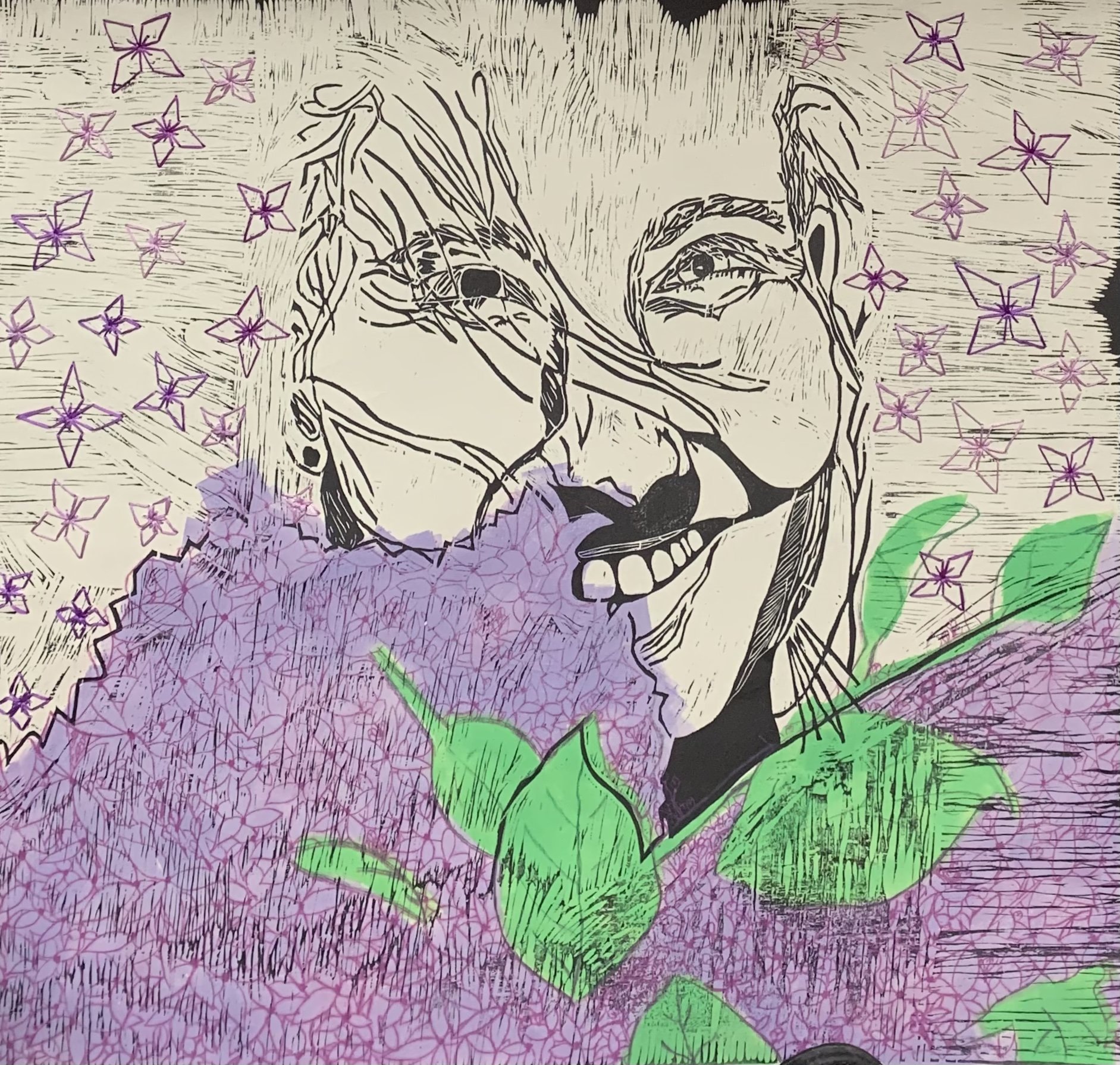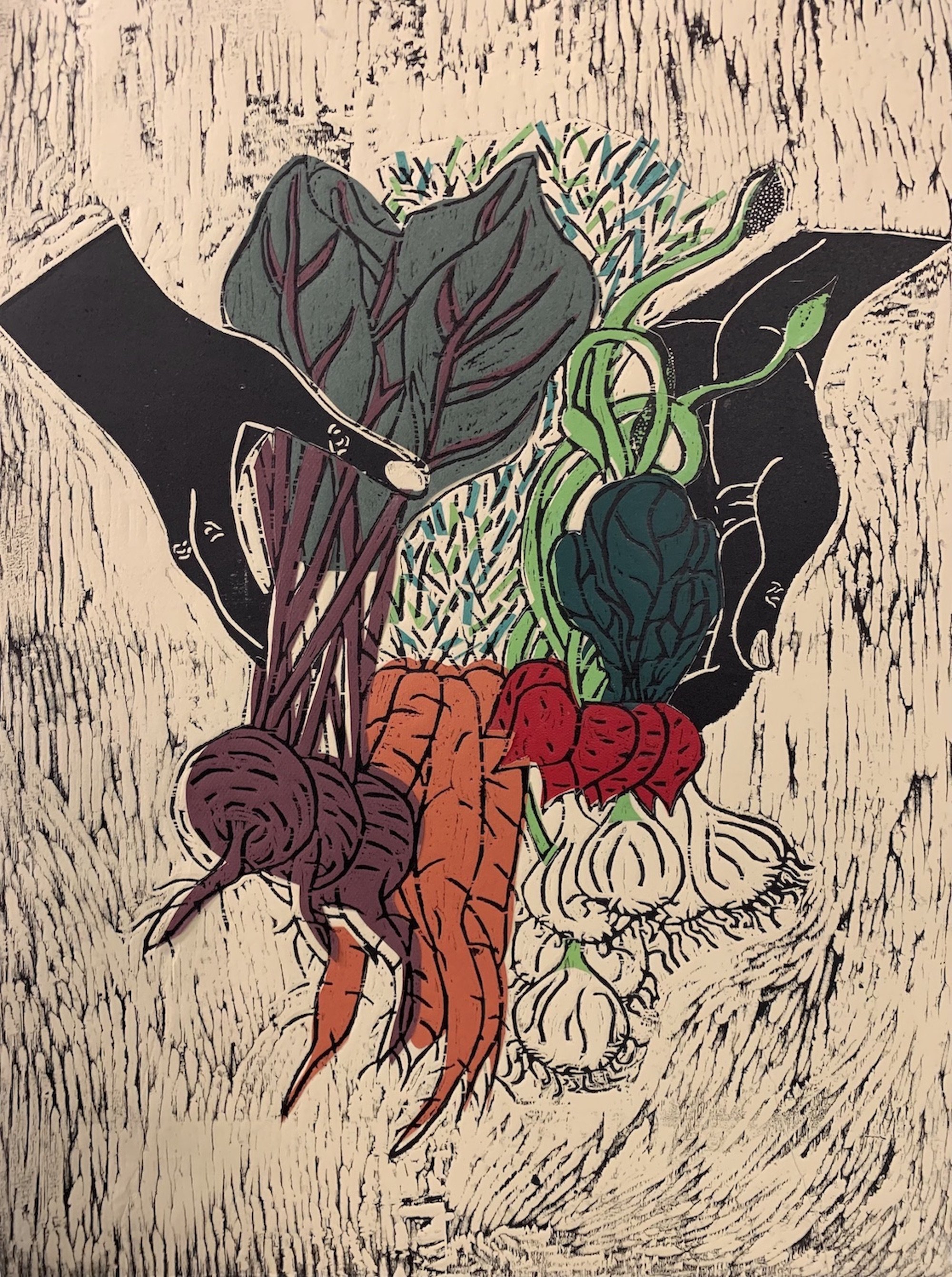Under The Big Top
Charlotte Holt
Under The Big Top, watercolor and ink on rag paper, 9 x 6 inches
“I like playing with how I can move beyond the traditional print methods.”
Interview by L. Valena
February 20, 2023
Can you start by describing the prompt that you responded to?
It was a haiku about an arachnid in the big top, and the crowd scurrying away.
What were your first thoughts or feelings?
I definitely took it a little more literally. You don't really think about spiders at the circus, so I really liked that concept. I also thought a lot about the way it was written, because the D's were capitalized. I thought it must mean something, but that didn't spark anything in particular, so I thought I would take it more literally.
Where did you go from there?
I'm a printmaker, so that was the trajectory that I had anticipated going with. I actually had done a circus-themed print before, but never any spiders. I like to create a reference image for myself, which I'm including here. I was playing around with that and trying to figure out how I wanted to frame things. Then I used that to make a drawing. I wanted to use pieces of linoleum that I had lying around, so that actually dictated the size more than I was anticipating. At first I was going to make the spider a lot smaller, but then I drew it bigger, and the moment I had, I knew that it was the right size. Then I wanted to make the tent bigger, but I didn't have enough linoleum, so I decided that they would be about the same size. At first I was going to do a really classic print, with one image on one block. But a lot of it was dictated by the supplies I had. Then I was running out of time, and didn't make it to the print studio, so I was trying to figure out how to print it at home with the stuff that I had.
There's an artist I've been following named Emma Stephens, who goes by the name Spoons and Violets online. I've been watching a lot of their content about this older printmaking technique called white line woodcut, in which you actually use watercolors on woodblocks and create the layers through the paint. The spider I was able to print just using a regular stamp pad. I tried to do the same with the circus tent but it just wasn't working. I wondered if I could use watercolor on the linoleum. I was actually very pleased by how they came out. I ended up cutting them out and putting them together.
Is that something that you've played with in the past? This practice of printing two images and then kind of collaging them together?
A little bit. It's definitely a direction I'm moving in. This time last year, I did a piece that I really love called Quilted Harvest. I carved a huge woodblock print of hands holding vegetables, and I wanted to add color. I ended up creating a collage with colored paper to add the color for each vegetable and then printed on top of that. I really liked that process. I have one version of that print done that way, and then I also added watercolor to other versions since then. I've been finding that when I'm in a creative rut, collage helps. So they're definitely starting to merge more and more. I've done some prints where I've embroidered on top of the print. I like playing with how I can move beyond the traditional print methods.
Embroidery? How cool!
Yeah. I did a self-portrait in 2020, which was the first time I did embroidery on a print. It was of me holding a bunch of lilacs, and then I embroidered all of the lilac florets around my head.
That's lovely. By the way, I love your spider.
I was looking at stock images of spiders, and realizing that they're all kind of silly looking. They're not scary when they're in a beautiful close-up.
You said you've made a circus tent print before?
Yeah! I was fortunate to be able to take a letterpress class my senior year of high school through the continuing education program at Harvard. They had so many blocks there -- metal engraved blocks, everything that was used for publications. One of our assignments was to pick a block from the collection and create something inspired by that. So I found this really great, very detailed clown and elephant. The type I set for it said, "Some days you just want to run away to the circus." Then I carved a circus tent to print with that also. And it was one of the first woodblocks I ever carved!
Wow! Strangely formative, huh? Cool! [Both laugh]
Yeah. Actually, I kept that edition of prints for a long time. I’ve sold a lot of them, and people have always really loved that one.
How did you get into printmaking?
I took that class in high school, but that was kind of like a one-off. In college I knew I wanted to do studio art. I went to Smith College in Western Mass. When I toured Smith, I saw the print studio, and I just knew that I wanted to be there. I took drawing and painting in college, and was always frustrated by painting. I was hung up on trying to be hyper realistic, and that's just not where my style is. Then I took a relief printmaking class my sophomore spring, which was really fun and felt closer to the idea that what I draw doesn't have to be the final piece. I also just wanted to spend all of my time in that print studio. I just felt really at home in the space; it was one of the most beautiful places on campus. So I just started taking as many printmaking classes as I could.
How beautiful to just kind of fall in love with something like that.
I really did. It was a really incredible experience. I felt like I walked away from college with a really practical, tactical skill. Being in a liberal arts setting, a lot of the other things you learn aren't as tangible. I can think really well, and that's what they sell you, but I'm very pleased to have a craft, even if it's maybe a dying practice.
It doesn't have to be!
No! And now that I'm out of college, I can see that it's really not a dying craft. I'm part of a pretty vibrant print community here in Philly.
Do you think you'll experiment more with watercolor and print?
Yes. It's definitely a direction I keep moving in. I like monotype, but sometimes I get hung up on the trial and error and messiness of it all. I don't always have the energy to be in the studio and go through that process. Watercolor is a way of creating that painterly element and to create monotype one-off prints without getting hung up in the mixing of colors. It feels weird to say that it avoids the messiness, but... the time it takes to set up and clean up the press.
Why does it feel weird to say that?
I don't know. So much about the artistic process is about being messy.
It's so messy. Sometimes you just wake up in the morning and say to yourself, "What's the biggest mess I can make today?" [Both laugh]
But with the watercolor, I can make it at home. I also just took a digital embroidery class, which was really cool. I really want to try adding that into my practice as well.
Do you have any advice for another artist approaching this project for the first time?
Just have fun with it. I felt like I had been in a little bit of a rut and this really helped with that. It's so easy to get caught up in your own style and your own imagery. Just do what first comes to mind. Don't overthink it, and just have fun.
Call Number: M68PP | M70VA.hoUnde
Charlotte Holt is a Philly based artist and printmaker, who was born and raised in Massachusetts. Holt predominantly works in the relief medium, creating intricate hand carved woodblock and linocut prints. Holt’s work strives to encapsulate the tenderness of the human experience and our relationship to the natural world.






